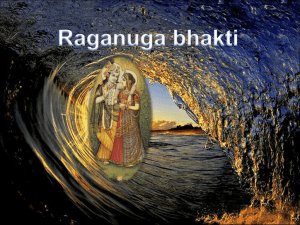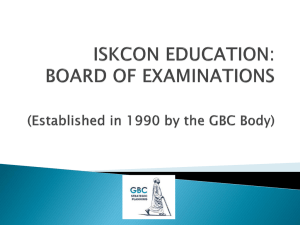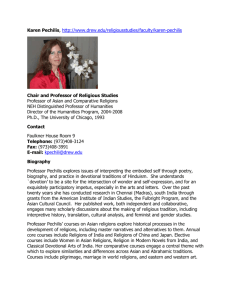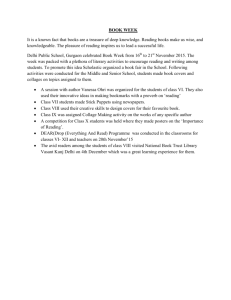Religion G ****
advertisement
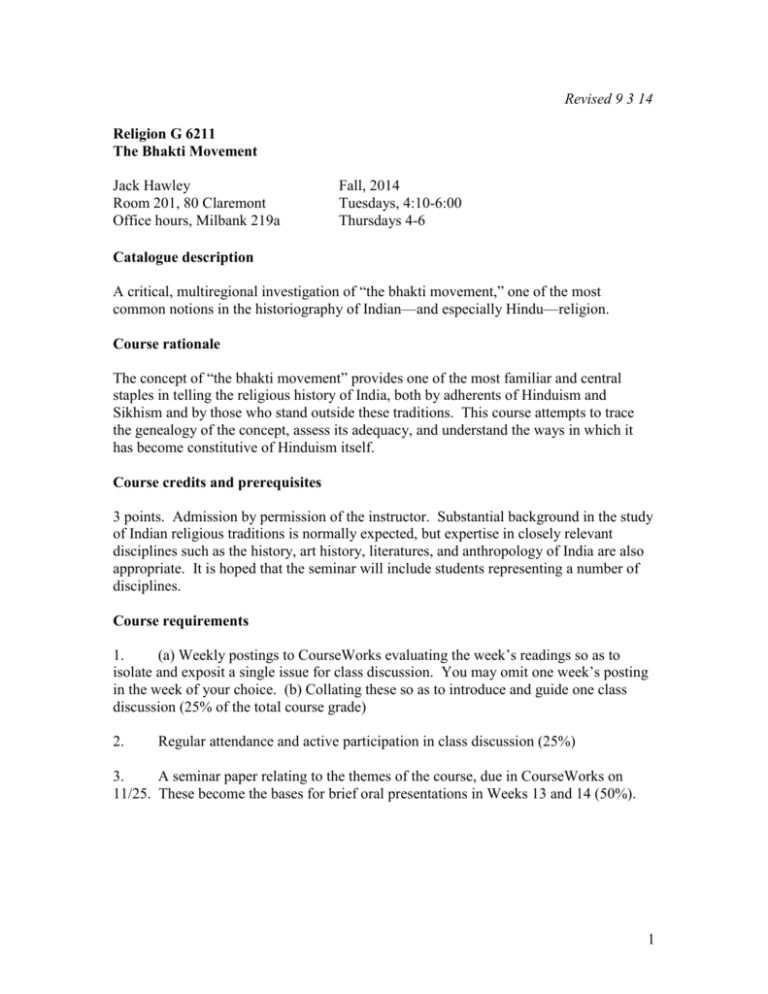
Revised 9 3 14 Religion G 6211 The Bhakti Movement Jack Hawley Room 201, 80 Claremont Office hours, Milbank 219a Fall, 2014 Tuesdays, 4:10-6:00 Thursdays 4-6 Catalogue description A critical, multiregional investigation of “the bhakti movement,” one of the most common notions in the historiography of Indian—and especially Hindu—religion. Course rationale The concept of “the bhakti movement” provides one of the most familiar and central staples in telling the religious history of India, both by adherents of Hinduism and Sikhism and by those who stand outside these traditions. This course attempts to trace the genealogy of the concept, assess its adequacy, and understand the ways in which it has become constitutive of Hinduism itself. Course credits and prerequisites 3 points. Admission by permission of the instructor. Substantial background in the study of Indian religious traditions is normally expected, but expertise in closely relevant disciplines such as the history, art history, literatures, and anthropology of India are also appropriate. It is hoped that the seminar will include students representing a number of disciplines. Course requirements 1. (a) Weekly postings to CourseWorks evaluating the week’s readings so as to isolate and exposit a single issue for class discussion. You may omit one week’s posting in the week of your choice. (b) Collating these so as to introduce and guide one class discussion (25% of the total course grade) 2. Regular attendance and active participation in class discussion (25%) 3. A seminar paper relating to the themes of the course, due in CourseWorks on 11/25. These become the bases for brief oral presentations in Weeks 13 and 14 (50%). 1 Books available for purchase at BookCulture Vinay Dharwadker, Kabir: The Weaver’s Songs (Delhi: Penguin, 2003). John Stratton Hawley, The Memory of Love (New York: Oxford University Press, 2009). David N. Lorenzen, ed., Religious Movements in South Asia, 600-1800 (Delhi: Oxford University Press, 2004). Velcheru Narayana Rao and David Shulman, God on the Hill: Temple Poems from Tirupati [by Annamayya] (New York: Oxford University Press, 2005). Christian Lee Novetzke, Religion and Public Memory (New York: Columbia University Press, 2008; paperback, 2011). A. K. Ramanujan, Speaking of Ṥiva (London: Penguin, 1973). Required selections from the following (which are out of print and hard to obtain) will be available on Courseworks. If you can find a hard copy, however, I recommend that you do so. Krishna Sharma, Bhakti and the Bhakti Movement: A New Perspective (New Delhi: Munshiram Manoharlal, 1987). Eleanor Zelliot and Rohini Mokashi-Punekar, eds., Untouchable Saints: An Indian Phenomenon (Delhi: Manohar, 2005). 2 Course Syllabus NB: Required readings are listed without any special qualification. If they do not come from books listed as being available for purchase, they can be found in CourseWorks— primarily in e-reserves, but in the case of Krishna Sharma and the Zelliot and Mokashi:Punekar volume, in Files & Resources. Readings that are listed in brackets under the heading “Compare” are supplementary. 9/2 Week 1. Introduction to the course Note: I keep trying to fill out my sense of the mental geography of the concept “bhakti movement”—and, in particular, to enrich my knowledge as it relates to the regional languages of India. If you come across something you think might have escaped me, I’d be most grateful for a note. Many thanks, JSH. 9/7 Week 2. The State of the Trope and the State of Scholarship Coordinator: John Strasser http://en.wikipedia.org/wiki/Bhakti movement. Prema Nandakumar, “The Bhakti Movement in South India” and “The Bhakti Movement in North India,” chapters 24-25 in R. Balasubramanian, ed., Theistic Ved¹nta, being vol. 3, part 3 of D. P. Chattopadhyaya, gen. ed., History of Science, Philosophy and Culture in Indian Civilization (New Delhi: Centre for Studies in Civilizations, 2003), pp. 790-810, 841-859, 879-904. Satish Chandra, “Historical Background to the Rise of the Bhakti Movement in Northern India,” in Chandra, Historiography, Religion, and State in Medieval India (New Delhi: Har-Anand, 1996), pp. 110-131. David N. Lorenzen, “Bhakti,” in Sushil Mittal and Gene Thursby, eds., The Hindu World (New York: Routledge, 2004), pp. 185-209. Karen Pechilis Prentiss, The Embodiment of Bhakti (New York: Oxford University Press, 1999), introduction and chapters 1-2, pp. 3-41, 211-219. John Cort, “Bhakti in the Early Jain Tradition: Understanding Devotional Religion in South Asia,” History of Religions 42:1 (2002), pp. 59-86. Available through JSTOR. The following two bibliographical works are meant as points of reference for the entire course: 3 Eleanor Zelliot, “The Medieval Bhakti Movement in History,” in Bardwell L. Smith, ed., Hinduism: New Essays in the History of Religions (Leiden: E. J. Brill, 1976), pp. 143-168. Philip Lutgendorf, “Medieval Devotional Traditions: An Annotated Survey of Recent Scholarship,” in Arvind Sharma, ed., The Study of Hinduism (Columbia, SC: University of South Carolina Press, 2003), pp. 200-260. [On reserve in Butler.] 9/16 Week 3. Historicizing the Trope Coordinator: Coco Vonnegut Krishna Sharma, Bhakti and the Bhakti Movement: A New Perspective (New Delhi: Munshiram Manoharlal, 1987), chapters 1-4 (pp. 1-108). [Also closely relevant: chapter 5, “Bhakti in the Classical Texts,” pp. 109-129 and Note B , “An Observation on the Theory of the Southern Origins of Bhakti” (pp. 296-314). ] John Stratton Hawley, A Storm of Songs: India and the Idea of the Bhakti Movement (Cambridge: Harvard University Press, forthcoming 2015), introduction and chapters 1-2, “The Bhakti Movement and its Discontents” and “The Transit of Bhakti.” Srimad Bhagavata Mahapurana with an English translation by C. L. Goswami (Gorakhpur: Gita Press, n.d.), pp. 1-48, containing the Bhagavata Mahatmya. George A. Grierson, “Bhakti-Marga,” in James Hastings, ed., Encyclopaedia of Religion and Ethics (Edinburgh: T. and T. Clarke, 1909), vol. 2, pp. 539-551. Vijay Pinch, “Bhakti and the British Empire,” Past and Present 179 (2003), pp. 159-196. [Compare: Peter van der Veer, “Monumental Texts: The Critical Edition of India’s National Heritage,” in Daud Ali, ed., Invoking the Past: The Uses of History in South Asia (Delhi: Oxford University Press, 2001), pp. 134-155. [Compare: Vasudha Dalmia, The Nationalization of Hindu Traditions (Delhi: Oxford, 1997), chapter 6.] 9/23 Week 4. Bhakti Movement > Religious Movements Coordinators: Marguerite Mott and Nick Tackes David N. Lorenzen, ed., Religious Movements in South Asia, 600-1800 (Delhi: Oxford University Press, 2004), introduction and chapters 1-6, pp. 1-226, and a snippet of Romila Thapar, pp. 353-357. 4 [Compare: J. N. Farquhar, Modern Religious Movements in India (New Delhi: Munshiram Manoharlal, 1977; originally 1915).] [Compare: Jayant Lele, ed., Tradition and Modernity in Bhakti Movements, special issue of the Journal of Asian and African Studies 15:1-2 (1980), introduction, pp. 1-15.] [Compare: Stephen Fuchs, Rebellious Prophets: A Study of Messianic Movements in Indian Religions (Bombay: Asia Publishing House, 1965), especially “Introduction” and “Messianic Movements,” pp. ix-xiv and 1-20.] [Compare: The Bhakti Movement—Says Who?, special issue of The International Journal of Hindu Studies, vol. 11:3 (2007), pp. 209-324.] 9/30 Week 5. A Bhakti Movement in Tamilnadu? Coordinators: Aalekhya Malladi and Sohini Pillai A. K. Ramanujan, Hymns for the Drowning: Poems for Visnu by Nammalvar (Princeton: Princeton University Press, 1981; paperback Penguin, 1993), afterword, pp. 103-169. Indira Viswanathan Peterson, Poems to Siva: The Hymns of the Tamil Saiva Saints (Princeton: Princeton University Press, 1989), chapters 1-4, pp. 3-75. R. Champakalakshmi. “Bhakti and Tamil Textual Tradition.” Tattvabodha: Essays from the Lecture Series of the National Mission for Manuscripts, vol. 1. Delhi: National Mission for Manuscripts and Munshiram Manoharlal, 2006, pp. 81-108. [Compare: Vidya Dehejia, Slaves of the Lord: The Path of the Tamil Saints (Delhi: Munshiram Manoharlal, 1988), chapters 1-3, and 8 (pp. 1-32, 139-150) and relevant plates. Also recommended: chapters 4 and 6, pp. 33-69, 87-116. The book is on reserve in Butler.] [Compare: Friedhelm Hardy, Viraha-Bhakti: The Early History of Krsna Devotion in South India (Delhi: Oxford University Press, 1983), from part 1: “General introduction,” pp. 36-48. [Compare: Norman Cutler, Songs of Experience: The Poetics of Tamil Devotion (Bloomington: Indiana University Press, 1987).] [Compare: Steven Paul Hopkins, Singing the Body of God: The Hymns of Vedantadesika in Their South Indian Tradition (New York: Oxford University Press, 2002).] 5 [Compare: Vidya Dehejia, Antal and Her Path of Love: Poems of a Woman Saint from South India (Albany: SUNY Press, 1990). [Compare: Archana Venkatesan, The Secret Garland: Antal’s Tiruppavai and Nacciyar Tirumoli (New York: Oxford University Press, 2010).] [Compare: Archana Venkatesan, [[On Nammalvar]] ] [Compare: Mariasusai Dhavamony, Love of God According to Saiva Siddhanta (Oxford: Clarendon Press, 1971), pp. 1-121.] [Compare: Dennis Hudson on Bhagavatism as an early and persistent formation. A general introduction can be had in the Journal of Vaishnava Studies 11:1 (2002), an issue devoted entirely to his work. Two complementary essays of Hudson appear there, but Richard Davis’s essay “Hudson Rethinks Bhagavata Thoughts” (pp. 27-44) may provide the most convenient point of departure. Also D. Dennis Hudson Krishna’s Mandala: Bhagavata Religion and Beyond, ed. J. S. Hawley (Delhi: Oxford University Press, 2009), part 2 (pp. 93-153).] 10/7 Week 6. The Virasaivas in the Pan-Indian Bhakti Narrative Coordinator: Nick O’Connell A. K. Ramanujan, Speaking of Siva (London: Penguin, 1973), especially Introduction, pp. 19-55. Sheldon Pollock, “The Cosmopolitan Vernacular,” Journal of Asian Studies 57:1 (1998), pp. 6-37. [JSTOR] Girish Karnad, Tale-Danda (Delhi: Ravi Dayal, 1993), entire (91 pp.). Julia Leslie, “Understanding Basava: History, Hagiography, and a Modern Kannada Drama,” Bulletin of the School of Oriental and African Studies 61:2 (1998), pp. 228-261. [Compare: Sheldon Pollock, ed., Literary Cultures in History (Berkeley: University of California Press, 2003), introduction, pp. 1-36, and D. R. Nagaraj, “Critical Tensions in the History of Kannada Literary Culture,” pp. 323-382.] [Compare: Leela Mullatti, The Bhakti Movement and the Status of Women: A Case Study of Virasaivism (New Delhi: Abhinav Publications, 1989) 6 10/14 Week 7. Namdev and Maharashtrian Kirtan Coordinators: Manpreet Kaur and Coleman Rainey Christian Lee Novetzke, Religion and Public Memory: A Cultural History of Saint Namdev in India (New York: Columbia University Press, 2008). [Compare: Christian Lee Novetzke, “Bhakti as Public Culture,” International Journal of Hindu Studies 11:3 (2008), pp. 255-272.] [Compare: Justin E. Abbott and Narhar R. Godbole, Stories of Indian Saints: English Translation of Mahipati's Marathi Bhaktavijaya (Delhi: Motilal Banarsidass, 1982; originally Poona: Scottish Mission Industries, 1934).] [Compare: Winand M. Callewaert and Mukund Lath, The Hindī Songs of Nāmdev (Leuven: Departement Orientalistiek, 1989).] 10/21 Week 8. 15th and 16th Centuries Padam, Pad, Premakhyan: Genre and Transfer in the Coordinators: Zeina Butt and Beatriz Simonsohn Velcheru Narayana Rao and David Shulman, God on the Hill: Temple Poems from Tirupati [by Annamayya] (New York: Oxford University Press, 2005). A. K. Ramanujan, Velcheru Narayana Rao, and David Shulman, When God Is a Customer (Berkeley: University of California Press, 1994), preface and introduction (pp. 1-40) and selected songs. [Three copies are in the Columbia library system, including one that does not circulate, in the South Asia Reading Room.] John Stratton Hawley, The Memory of Love: Sūrdās Sings to Krishna (New York: Oxford University Press, 2009), introduction, pp. 3-44, and browse. Simon Digby, “The Sufi Shaikh as a Source of Authority in Medieval India,” in Marc Gaborieau, ed., Islam et Societé en Asie du Sud: Collection Purusartha 9 (Paris: Ecole des Hautes Etudes en Sciences Sociales, 1986), pp. 57-77. Aditya Behl, “How Newness Enters the World: Inaugurating a Genre,” lecture delivered at the École des Hautes Études en Sciences Sociales, Paris, 2005. Aditya Behl, “Presence and Absence in Bhakti: An Afterword, International Journal of Hindu Studies 11:3 (2008), pp. 319-324. 7 [Compare: Philip Lutgendorf, The Life of a Text: Performing the Ramcaritmanas of Tulsidas (Berkeley: University of California Press, 1991).] [Compare: J. S. Hawley, India’s Real Religion: The Idea of the Bhakti Movement, chapter 4, “The View From Brindavan” (in draft).] [Compare: Friedhelm Hardy, “Madhavendra Puri: A Link Between Bengal Vaisnavism and South Indian Bhakti,” Journal of the Royal Asiatic Society no. 1 (1974), pp. 23-41.] 10/28 Week 9. the Niranjanis A Nirguna Bhakti Movement?: Kabir, Nanak, Dadu, and Guest: Tyler Williams, University of Pennsylvania Coordinators: Maneeta Doshi and Prabhleen Kaur David N. Lorenzen, ed., Religious Movements in South Asia, 600-1800, part 4: Kabir and the Sants,” with selections from P. D. Barthwal and Hajariprasad Dvivedi, pp. 251-287. Vinay Dharwadker, Kabir: The Weaver’s Songs (Delhi: Penguin, 2003), introduction, pp. 1-95. Gurinder Singh Mann, Sikhism (Upper Saddle River, NJ: Prentice Hall, 2004), pp. 13- 54. Tyler W. Williams, “Sacred Sounds and Sacred Books: A History of Writing in Hindi,” chapter 5: “From Sacred Sound to Sacred Book,” pp. 268-355. Ph.D. dissertation, Columbia University, 2014. [Compare: Gurinder Singh Mann, “Guru Nanak’s Life and Legacy: An Appraisal” (unpublished essay).] [Compare: John Stratton Hawley, Three Bhakti Voices (Delhi: Oxford University Press, 2005), chapter 1, “Author and Authority,” pp. 21-47, or via JSTOR to The Journal of Asian Studies, where it was initially published.] [Compare: David N. Lorenzen, “Traditions of Non-caste Hinduism: The Kabir Panth,” in Lorenzen, Who Invented Hinduism?: Essays on Religion in History (New Delhi: Yoda Press, 2006), pp. 78-101.] [Compare: Karine Schomer, “Kabir in the Guru Granth Sahib: An Exporatory Essay,” in Mark Juergensmeyer and N. Gerald Barrier, eds., Sikh Studies: Comparative 8 Perspectives on a Changing Tradition (Berkeley: Berkeley Religious Studies Series, 1979), pp. 75-86.] [Compare: Krishna Sharma, Bhakti and the Bhakti Movement: A New Perspective, chapter 7, “Kabir and the Antecedents of his Nirguna School,” pp. 162-197.] 11/4 University Holiday: Election Day 11/11 Week 10. The Ramanandis and the Four Sampradays Coordinators: Joya John and Sahaj Patel John Stratton Hawley, A Storm of Songs: India and the Idea of the Bhakti Movement, chapter 3, “The Four Sampradāys and the Community of Love” [Compare: Chapter 5, “Victory in the Cities of Victory.”] James P. Hare, “Contested Communities and the Re-Imagination of Nābhādās’s Bhaktamāl, in Anne Murphy, ed., Time History, and the Religious Imaginary in South Asia (London and New York: Routledge, 2011), pp. 150-166. Patton Burchett, “Two Hanumāns in One: Rasiks and Yogīs in the Rāmānandī Bhakti Lineage of Galtā,” chapter 2 of the dissertation Bhakti Religion and Tantric Magic in Mughal India: Kacchwāhās, Rāmānandīs, and Nāths, ca. 1500-1750 (Columbia, 2012). Richard Burghart, “The Founding of the Ramanandi Sect,” Ethnohistory 25:2 (1978), pp. 121-137, reprinted in Lorenzen, ed., Religious Movements in South Asia, pp. 227-250. William R. Pinch, “History, Devotion, and the Search for Nabhadas of Galta,” in Daud Ali, ed., Invoking the Past: The Uses of History in South Asia (Delhi: Oxford University Press, 1999), pp. 367-399. Purushottam Agrawal, “In Search of Ramanand, the Guru of Kabir and Others,” in Ishita Banerjee-Dube and Saurabh Dube, eds., Ancient to Modern: Religion, Power, and Community in India (Delhi: Oxford University Press, 2009), pp. 135-170. [Compare: Monika Horstmann, “The Ramanandis of Galta (Jaipur, Rajasthan),” in Lawrence A. Babb, Varsha Joshi, and Michael Meister, eds., Multiple Histories: Culture and Society in the Study of Rajasthan (Jaipur: Rawat Publications, 2002), pp. 141-197.] 9 [Compare: Krishna Sharma, Bhakti and the Bhakti Movement: A New Perspective, “Vaishnava Systems of Vedanta,” pp. 140-147.] 11/18 Week 11. Dalit Bhakti as a Historical Formation Coordinator: Aman Kumar Eleanor Zelliot and Rohini Mokashi-Punekar, eds., Untouchable Saints: An Indian Phenomenon (Delhi: Manohar, 2005), selections. [The entire class will read the introduction, pp. 9-51. The remainder of the book will be apportioned in regional sections—south, west, and north.] Karine Schomer, “The Sant Tradition in Perspective,” in Karine Schomer and W. H. McLeod, eds., The Sants: Studies in a Devotional Tradition of India (Berkeley: Berkeley Religious Studies Series and Delhi: Motilal Banarsidass, 1987), pp. 1-17. Ramdas Lamb, Rapt in the Name: The Ramnamis, Ramnam, and Untouchable Religion in Central India (Albany: SUNY Press, 2002), chapter 4, “Religion and the Low Caste in Central India,” pp. 45-75. Patton Burchett, “Bhakti Rhetoric in the Hagiography of ‘Untouchable’ Saints: Discerning Bhakti’s Ambivalence on Caste and Brahminhood,” International Journal of Hindu Studies 13:2 (2009), pp. 115-141. John Stratton Hawley, A Storm of Songs: India and the Idea of the Bhakti Movement (Cambridge: Harvard University Press, forthcoming 2015), chapter 7, “What Should the Bhakti Movement Be?” [Compare: Jon Milton Keune, “Eknāth Remembered and Reformed: A 16thcentury Marathi Sant and Caste in Marathi Historiography,” Ph.D. dissertation, Columbia University, 2011.] [Compare: Gail Omvedt, Buddhism in India: Challenging Brahmanism and Caste (New Delhi: Sage Publications, 2003), chapter 6: “After Buddhism: The Bhakti Movements,” pp. 186-216.] [Compare: Saurabh Dube, Untouchable Pasts: Religion, Identity, and Power among a Central Indian Community, 1780-1950 (Albany: SUNY Press, 1998).] [Compare: David Lorenzen, “The Historical Vicissitudes of Bhakti Religion,” in Lorenzen, ed., Bhakti Religion in North India: Community Identity and Political Action (Albany: SUNY Press, 1995), pp. 1-32.] 10 11/25 Week 12. 11/26. Writing Break. Papers due in CourseWorks by midnight No class meeting; I must be away from campus at the AAR meetings. Please post your papers to the “Discussion Board” listing in CourseWorks 12/2,9 Weeks 13-14. Presentation and Discussion of Student Papers The assignment in this and the following week is to read the papers scheduled for discussion on the day of the seminar. 11

